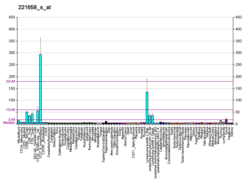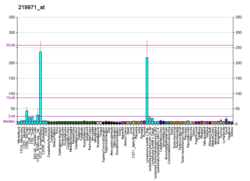Interleukin 21 receptor is a type I cytokine receptor. IL21R is its human gene.[5]
The protein encoded by this gene is a cytokine receptor for interleukin 21 (IL21). It belongs to the type I cytokine receptors, and has been shown to form a heterodimeric receptor complex with the common gamma-chain, a receptor subunit also shared by the receptors for interleukin 2 (IL2), interleukin 7 (IL7) and interleukin 15 (IL15). This receptor transduces the growth promoting signal of IL21, and is important for the proliferation and differentiation of T cells, B cells, and natural killer (NK) cells. The ligand binding of this receptor leads to the activation of multiple downstream signaling molecules, including JAK1, JAK3, STAT1, and STAT3. Knockout studies of a similar gene in mouse suggest a role for this gene in regulating immunoglobulin production. Three alternatively spliced transcript variants encoding the same protein have been described.[5]
Further reading
- Adams MD, Kerlavage AR, Fleischmann RD, et al. (1995). "Initial assessment of human gene diversity and expression patterns based upon 83 million nucleotides of cDNA sequence" (PDF). Nature. 377 (6547 Suppl): 3–3. PMID 7566098.
- Ozaki K, Kikly K, Michalovich D, et al. (2000). "Cloning of a type I cytokine receptor most related to the IL-2 receptor beta chain". Proc. Natl. Acad. Sci. U.S.A. 97 (21): 11439–11444. doi:10.1073/pnas.200360997. PMC 17218. PMID 11016959.
- Parrish-Novak J, Dillon SR, Nelson A, et al. (2000). "Interleukin 21 and its receptor are involved in NK cell expansion and regulation of lymphocyte function". Nature. 408 (6808): 57–63. doi:10.1038/35040504. PMID 11081504.
- Asao H, Okuyama C, Kumaki S, et al. (2001). "Cutting edge: the common gamma-chain is an indispensable subunit of the IL-21 receptor complex". J. Immunol. 167 (1): 1–5. doi:10.4049/jimmunol.167.1.1. PMID 11418623.
- Strausberg RL, Feingold EA, Grouse LH, et al. (2003). "Generation and initial analysis of more than 15,000 full-length human and mouse cDNA sequences". Proc. Natl. Acad. Sci. U.S.A. 99 (26): 16899–16903. doi:10.1073/pnas.242603899. PMC 139241. PMID 12477932.
- Clark HF, Gurney AL, Abaya E, et al. (2003). "The secreted protein discovery initiative (SPDI), a large-scale effort to identify novel human secreted and transmembrane proteins: a bioinformatics assessment". Genome Res. 13 (10): 2265–2270. doi:10.1101/gr.1293003. PMC 403697. PMID 12975309.
- Jüngel A, Distler JH, Kurowska-Stolarska M, et al. (2004). "Expression of interleukin-21 receptor, but not interleukin-21, in synovial fibroblasts and synovial macrophages of patients with rheumatoid arthritis". Arthritis Rheum. 50 (5): 1468–1476. doi:10.1002/art.20218. PMID 15146416.
- Zhang Z, Henzel WJ (2005). "Signal peptide prediction based on analysis of experimentally verified cleavage sites". Protein Sci. 13 (10): 2819–2824. doi:10.1110/ps.04682504. PMC 2286551. PMID 15340161.
- Gerhard DS, Wagner L, Feingold EA, et al. (2004). "The status, quality, and expansion of the NIH full-length cDNA project: the Mammalian Gene Collection (MGC)". Genome Res. 14 (10B): 2121–2127. doi:10.1101/gr.2596504. PMC 528928. PMID 15489334.
- Distler JH, Jüngel A, Kowal-Bielecka O, et al. (2005). "Expression of interleukin-21 receptor in epidermis from patients with systemic sclerosis". Arthritis Rheum. 52 (3): 856–864. doi:10.1002/art.20883. PMID 15751077.
- Wu Z, Kim HP, Xue HH, et al. (2005). "Interleukin-21 receptor gene induction in human T cells is mediated by T-cell receptor-induced Sp1 activity". Mol. Cell. Biol. 25 (22): 9741–9752. doi:10.1128/MCB.25.22.9741-9752.2005. PMC 1280258. PMID 16260592.
- de Totero D, Meazza R, Zupo S, et al. (2006). "Interleukin-21 receptor (IL-21R) is up-regulated by CD40 triggering and mediates proapoptotic signals in chronic lymphocytic leukemia B cells". Blood. 107 (9): 3708–3715. doi:10.1182/blood-2005-09-3535. PMID 16391014.
- Pène J, Guglielmi L, Gauchat JF, et al. (2007). "IFN-gamma-mediated inhibition of human IgE synthesis by IL-21 is associated with a polymorphism in the IL-21R gene". J. Immunol. 177 (8): 5006–13. doi:10.4049/jimmunol.177.8.5006. PMID 17015683.
- Li J, Shen W, Kong K, Liu Z (2006). "Interleukin-21 induces T-cell activation and proinflammatory cytokine secretion in rheumatoid arthritis". Scand. J. Immunol. 64 (5): 515–522. doi:10.1111/j.1365-3083.2006.01795.x. PMID 17032244.
- Asano K, Ikegami H, Fujisawa T, et al. (2007). "Molecular scanning of interleukin-21 gene and genetic susceptibility to type 1 diabetes". Hum. Immunol. 68 (5): 384–391. doi:10.1016/j.humimm.2007.01.009. PMID 17462506.
- Akamatsu N, Yamada Y, Hasegawa H, et al. (2007). "High IL-21 receptor expression and apoptosis induction by IL-21 in follicular lymphoma". Cancer Lett. 256 (2): 196–206. doi:10.1016/j.canlet.2007.06.001. PMID 17624663.





